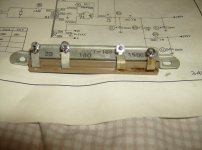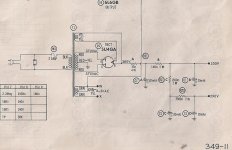The Patient: HH Scott Model 223
P/P Mono Amplifier
2X6L6
1X12AX7
1X 5U4G
(schematic attached)
After checking and replacing caps and resistors on my old Scott...I found one resistor (notated as R21 on schematic) that has me stumped.
See Pic: It appears to be some kind of multi-stage resistor with definite signs of distress (some kind of oily substance oozing from the seam with that definite acrid smell! (resistance readings confirm this thing is toast)
So is this some sort of multi-gang resistor?
I doubt that a replacement is still available given the age of this thing. How would I wire in individual replacement resistors of the same value. As this thing was mounted flush on the inside and flush to the frame itself I'm a little confused by that orientation. Was it attached to the frame as part of the heat dissipation factor?
Any advice greatly appreciated...Leo
P/P Mono Amplifier
2X6L6
1X12AX7
1X 5U4G
(schematic attached)
After checking and replacing caps and resistors on my old Scott...I found one resistor (notated as R21 on schematic) that has me stumped.
See Pic: It appears to be some kind of multi-stage resistor with definite signs of distress (some kind of oily substance oozing from the seam with that definite acrid smell! (resistance readings confirm this thing is toast)
So is this some sort of multi-gang resistor?
I doubt that a replacement is still available given the age of this thing. How would I wire in individual replacement resistors of the same value. As this thing was mounted flush on the inside and flush to the frame itself I'm a little confused by that orientation. Was it attached to the frame as part of the heat dissipation factor?
Any advice greatly appreciated...Leo
Attachments
Last edited:
It's several resistors in a single package. They go in the PSU. The schematic gives the values, positions, and wattage ratings. Belt and suspenders says increase the wattage ratings over OEM, if space and air flow permit. Low cost metal oxide parts should be suitable for this job.
It's several resistors in a single package. They go in the PSU. The schematic gives the values, positions, and wattage ratings. Belt and suspenders says increase the wattage ratings over OEM, if space and air flow permit. Low cost metal oxide parts should be suitable for this job.
Thanks Eli...I figured I could go that route. It's just that I just haven't run into one of these before and was wondering why this type of mult-stage resistor would have been used (wouldn't it actually increase the thermal wattage in this area making it more susceptible to breakdown/failure) instead of individual resistors with a lot of airflow and space around each one?...and why would it be mounted flush against the case?
Anyways...just my curiousity.
Last edited:
Eli, I'm shocked. Metal oxide resistors can't take much overload. I say use 5 and/or 10 watt wire wound types. They're much more reliable. The original is probably wire wound. And if it wasn't, it should be.Low cost metal oxide parts should be suitable for this job.
Eli, I'm shocked.
I did say increase the wattage ratings over OEM.
 WW or MO, increased wattage over OEM is the belt and suspenders way. The replacement should hold up, "under fire", longer than the OEM stuff.
WW or MO, increased wattage over OEM is the belt and suspenders way. The replacement should hold up, "under fire", longer than the OEM stuff.Doing so lets the chassis act as a heat sink. Using a multi section device was a cheaper way of doing things.I'm still interested as to why HH would place a resistor flush against the frame...?
Yes, you did. I just have a dislike of metal oxide/film resistors in power applications unless there's a real good reason for them.I did say increase the wattage ratings over OEM.
Doing so lets the chassis act as a heat sink.
That was my guess too
Using a multi section device was a cheaper way of doing things.
Jeez...must have saved at least .2 cents doing it that way.
Yes, you did. I just have a dislike of metal oxide/film resistors in power applications unless there's a real good reason for them.
So what's your objection to using MO/F Rs in power applications HollowState?
It is well known that metal film resistors cannot withstand a momentary severe overload from either a short or a pulse. Carbon compositions will just grunt and continue to function as will wire wounds. Films open up easily. Some folks like to use that phenomenon as a safety factor. But to me it is a PITA.
Last edited:
FWIW, I did some digging at Mouser. The MO stuff does not have the wattage headroom needed.  For the 160 Ω part, Mouser stock # 280-CR10-160-RC looks good. Thats a 64 cent, 10 W. rated, Xicon WW. As long as some airflow is present around that part, it should last for quite some time.
For the 160 Ω part, Mouser stock # 280-CR10-160-RC looks good. Thats a 64 cent, 10 W. rated, Xicon WW. As long as some airflow is present around that part, it should last for quite some time.
It is well known that metal film resistors cannot withstand a momentary severe overload from either a short or a pulse..
Thanks. It's now just a little more well known
FWIW, I did some digging at Mouser. The MO stuff does not have the wattage headroom needed.For the 160 Ω part, Mouser stock # 280-CR10-160-RC looks good. Thats a 64 cent, 10 W. rated, Xicon WW. As long as some airflow is present around that part, it should last for quite some time.
I do have some NOS wirewounds of the right values, that I'll recheck for spec...thanks for the reminder to ensure proper airflow...I still think the original multi-resistor in one package design was pretty cheaply thought out...but I guess HollowState's hunch that the chassis was utilized as a heat sink allowed them to get away with putting so much thermal wattage in such a confined area.
- Status
- This old topic is closed. If you want to reopen this topic, contact a moderator using the "Report Post" button.
- Home
- Amplifiers
- Tubes / Valves
- Help identify and replacement of ? resistor

